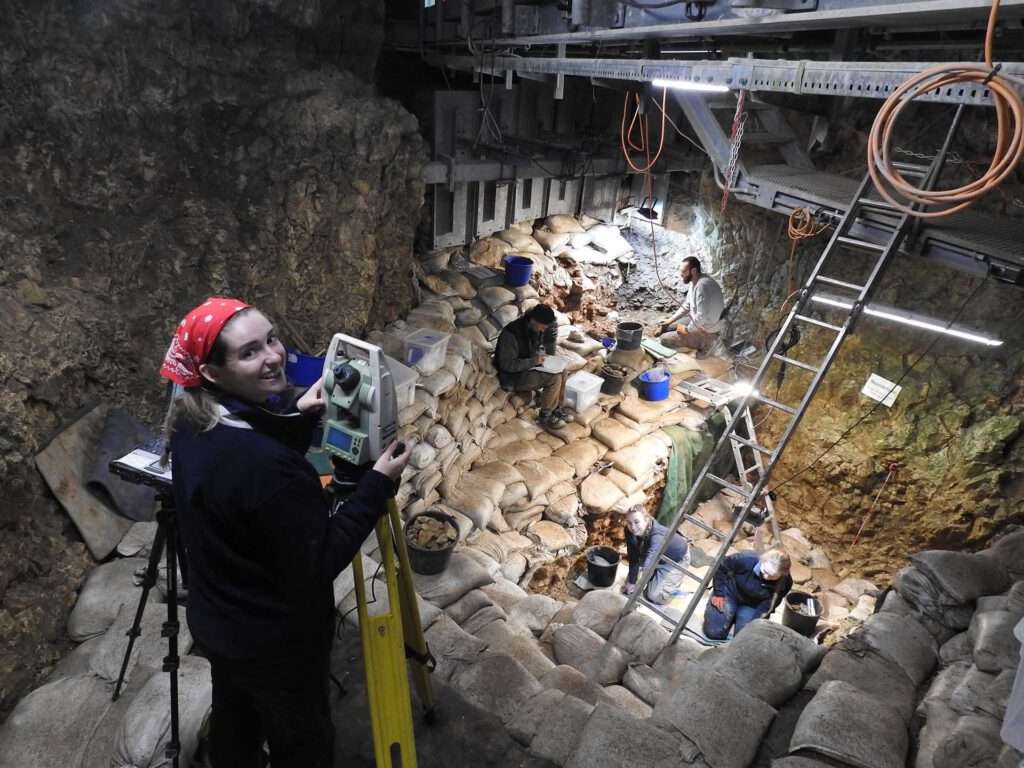Archaeology

Caves and their sediments represent invaluable archives for examining long-term demographic changes and relationships between humans, animals, plants and microorganisms, both within and outside of the immediate cave environment. Data acquisition for GACT will rely on samples obtained through targeted fieldwork, e.g. from UNESCO World Heritage Site Hohle Fels. The participating research departments include the Working Group Early Prehistory and Quaternary Ecology and the Institute for Archaeological Sciences with the Working Groups Geoarchaeology, Archaeobotany and Zooarchaeology as well as the Terrestrial Palaeoclimatology. Cooperation partners are the project „The Role of Culture in Early Expansions of Humans (ROCEEH) and the Archaeobotany Lab of the Heritage Department of Baden-Württemberg.
Collections and labs
The collection of the Division of Prehistory and Quaternary Ecology at the University of Tübingen represents one of the largest stone age collections in Germany. It maintains a considerable collection of archaeological finds, fossil hominid material, ethnographic finds, as well as photographic and written documentation from our field projects. Perhaps most remarkably, the ivory statuettes from Vogelherd are part of the Tübingen collection; they are amongst the oldest pieces of Paleolithic art.

The Geoarchaeology Working Group is responsible for curating the Geoarchaeology collection which, with over 15,000 objects, is the largest of its kind worldwide. The collection contains material collected from around the world and contains both, archeological and reference materials.
The archaeobotanical collection includes around 20,000 plant taxa, which are used primarily by archaeobotanists to determine plant finds from archaeological excavations. The laboratory includes several stereomicroscopes for fruit, seed and charcoal identification.
The zooarchaeology modern skeletal collection has 1500 micro- and macro remains from mammals, birds, fish, reptiles, and amphibians and material from ca. 120 archaeological sites. A fully equipped maceration laboratory for processing skeletal materials and a variety of analytical instruments and sampling preparation machines are available, including microtome and polishing equipment for processing thin sections, micro-drills for bone sampling, and diverse optical microscopes. In coordination with other groups, there is access to facilities for pre-processing samples for isotope analyses, 3D imaging and scanning equipment, and FTIR spectrometers.
The Working Group Terrestrial Palaeoclimatology offers a µCT imaging joint-lab of the Senckenberg Centre for Human Evolution and Palaeoenvironment and the Eberhard Karls Universität Tübingen.
Contact persons and Research Areas
(Senckenberg Centre for Human Evolution and Palaeoenvironment and University of Tübingen)
Early Prehistory and Quaternary Ecology
Prof. Nicholas J. Conard, PhD
The department has active excavations of archaeological sites in southern Africa and in southwestern Germany tackling different aspects of human material culture. During excavations, samples for all other disciplines will be taken.
Geoarchaeology
The Geoarchaeology studies the interaction between humans and the geosphere in the past. The group has extensive experience reconstructing formation processes of sedimentary archives in caves and have been central in methodological development for the extraction of aDNA from geoarchaeological samples.
Zooarchaeology
The zooarchaeology-team investigates micro- and macro-faunal remains in archaeological sites of the GACT-excavations.
Archaeobotany
Archaeobotanical analysis focuses on the study of the relationship between humans and plants and can be regarded as part of research into the history of vegetation. Plant macro- and micro-remains come from sediments and coprolites from cave excavations.
µCT imaging joint-lab
Expertise in 2D/3D sample imaging and digitalization with methods from palaeontology, use of computational methods and tools, especially micro-Computed Tomography (µCT).
The Role of Culture in Early Expansions of Humans (ROCEEH)
ROCEEH discovers, contextualizes, and preserves the deep past of humankind’s cultural heritage and addresses the questions related to what we call “becoming human.” The research center conducts excavations.